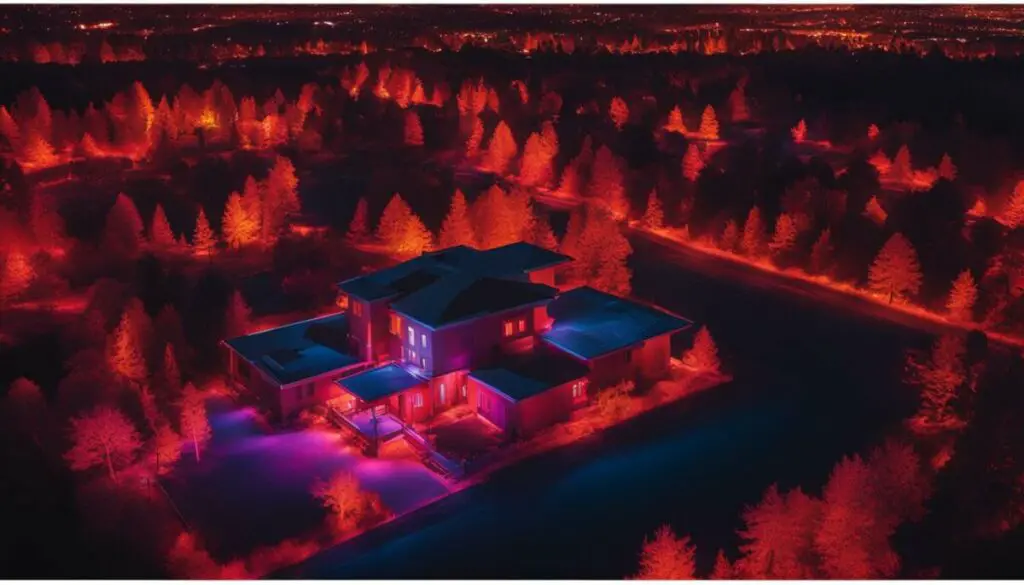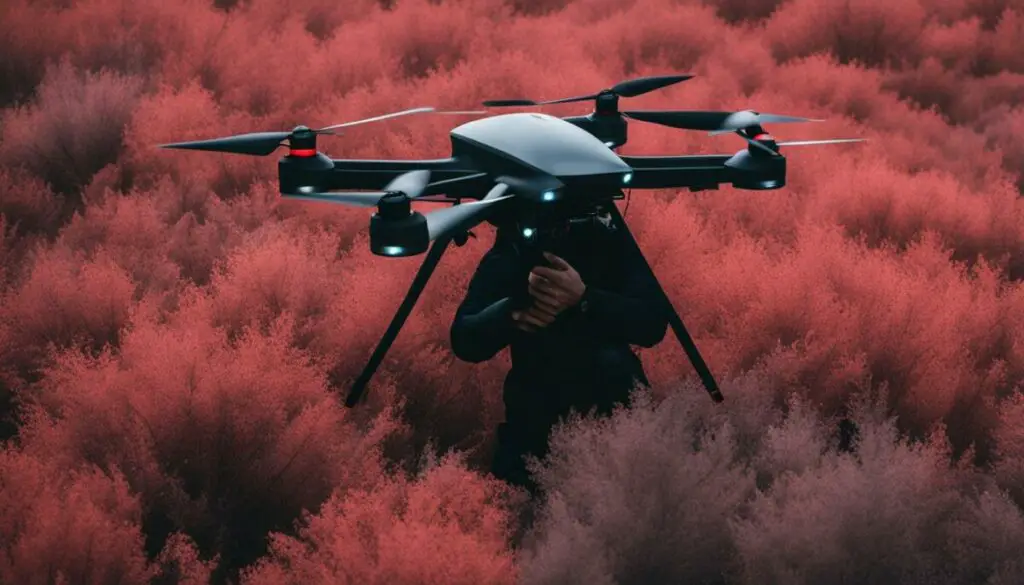Last Updated on 6 months by Francis
If you’re concerned about protecting your privacy from infrared drone surveillance, you’re not alone. Infrared drones have become increasingly popular for surveillance, and their advanced technology makes it difficult to evade detection. Fortunately, there are several techniques and strategies you can use to hide from infrared drones effectively.
In this section, we’ll provide an expert guide on how to effectively hide from infrared drones. We’ll explore various techniques and strategies to evade infrared drone detection and protect your privacy. By the end of this section, you’ll have a comprehensive understanding of how to hide from infrared drones and maintain your privacy in a tech-driven world.
Contents
Key Takeaways:
- Understanding the basics of infrared drone surveillance is crucial before devising hiding techniques.
- Cunningly camouflaging yourself or your surroundings is an essential technique to evade detection.
- Reducing your thermal signature with stealth techniques can help in hiding from infrared drones.
- Utilizing physical barriers and obstacles can make it hard for infrared drones to pinpoint your exact location.
- Infrared-reflective materials can deceive infrared drones and blend you into your surroundings.
Understanding Infrared Drone Surveillance

Infrared drone surveillance is becoming increasingly common, and it’s essential to understand how it works to protect your privacy. Infrared drones use thermal imaging cameras to detect heat signatures, which can easily identify individuals and objects, even in complete darkness.
These drones are often used by law enforcement agencies, military personnel, and private companies, among others. Infrared drone surveillance can be used for a variety of purposes, including search and rescue operations, monitoring wildlife, and identifying potential security threats.
However, it also poses a significant risk to personal privacy, and it’s important to take measures to protect yourself from infrared drone surveillance.
The Limitations of Infrared Drone Surveillance
While infrared drone surveillance is highly effective in detecting heat signatures, it has some limitations. Infrared cameras have a limited range, and their accuracy can be affected by weather conditions such as rain or fog. Additionally, these cameras cannot see through walls or other solid objects.
It’s essential to understand the capabilities and limitations of infrared drone surveillance to devise effective strategies for protecting your privacy.
Protecting Yourself from Infrared Drone Surveillance
There are several ways to protect yourself from infrared drone surveillance. One effective method is to avoid generating excess heat, which can make it harder for infrared cameras to detect your heat signature.
You can also use physical barriers such as walls, fences, or trees to disrupt infrared drone tracking. Additionally, wearing clothing that absorbs or reflects heat can help to reduce your thermal signature and make it more challenging for infrared drones to track your movements.
Ultimately, protecting yourself from infrared drone surveillance requires a combination of tactics and strategies. Understanding the technologies and techniques used for infrared drone detection is an important step in safeguarding your privacy.
Assessing Infrared Drone Detection Technologies

When it comes to evading infrared drone detection, it’s vital to understand the various technologies used for surveillance. These detection methods have become increasingly sophisticated, making it challenging to hide effectively. Here, we’ll explore some countermeasures against infrared drone detection and methods for infrared drone detection avoidance.
Infrared Drone Detection Technologies
Infrared drone detection technologies range from passive to active systems. Passive detection systems use thermal cameras to detect the heat signatures of objects. Active systems, on the other hand, emit infrared light that is reflected back by objects, which can be detected by the drone’s sensors. Here are some technologies commonly used for infrared drone detection:
| Detection Technology | Description |
|---|---|
| Thermal Cameras | Thermal cameras detect the heat signatures of objects, allowing drones to detect living entities and machinery. |
| Laser Rangefinders | Laser rangefinders emit a laser beam that measures distances to objects, allowing drones to make accurate measurements. |
| Infrared Sensors | Infrared sensors emit infrared light that is reflected back by objects, allowing drones to detect their presence. |
Ways to Avoid Infrared Drone Detection
Now that you understand the various technologies used for infrared drone detection, it’s time to explore some countermeasures. Here are some methods for infrared drone detection avoidance:
- Camouflage: As mentioned in the previous section, camouflage is an effective way to evade infrared drone detection. You can camouflage yourself or your surroundings using materials that absorb or reflect thermal radiation.
- Thermal Insulation: By wearing thermal insulation clothing, you can reduce your thermal signature and make it harder for infrared drones to detect you.
- Infrared-Reflective Materials: Using infrared-reflective materials can help you deceive infrared drones and blend into your surroundings, making it harder for them to detect your presence.
- Physical Barriers: Physical barriers like walls, trees, or other obstacles can disrupt infrared drone tracking, making it difficult for them to pinpoint your exact location.
- Electronic Jammers: Electronic jammers emit signals that interfere with the drone’s sensors, preventing them from detecting your presence.
By implementing these countermeasures, you can effectively avoid detection by infrared drones and protect your privacy.
Camouflage Techniques for Infrared Drone Evasion

Camouflage is one of the essential techniques to consider when trying to avoid infrared drone detection. Here are some effective infrared drone camouflage techniques:
- Wear clothing that matches your surroundings. For example, if you’re in a forested area, wear green or brown clothing.
- Use face paint or mud to match your skin tone with the environment.
- Utilize camouflage netting to cover yourself or your belongings from aerial infrared detection.
- Employ decoys to lure infrared drones away from your location.
It’s important to note that while camouflage is effective, it’s not a foolproof solution. Infrared drones have advanced technology that can detect motion, and they can differentiate between living and non-living objects.
To enhance your camouflage techniques, consider using thermal blankets to cover your body heat signature or surroundings. These blankets are made up of infrared-reflective material that makes it harder for infrared drones to detect your body heat.
Another way to avoid detection is to stay in areas with dense vegetation that can block infrared detection. You can also create heat-absorbing structures around your location, such as a lean-to or teepee, which can help to reduce your heat signature.
Ultimately, the best strategy is to combine various camouflage techniques to increase your chances of avoiding infrared drone surveillance. Remember, infrared drones are continually improving, so staying aware of their advancements and remaining updated on the latest infrared drone evasion methods is crucial.
Thermal Signature Reduction Methods

Thermal signature reduction methods are essential for evading infrared drones. By reducing your thermal signature, you can make yourself less visible to infrared detectors, making it harder for them to track your movements. Here are some stealth techniques that can help protect yourself from infrared drone surveillance:
Wearing Appropriate Clothing
Wearing the right type of clothing can help reduce your thermal signature. Avoid dark-colored clothing as it tends to absorb heat and radiate it back to the environment, which makes you more visible on thermal imaging devices. Instead, opt for light-colored clothing and materials made from polyester or other synthetic fibers. These materials are less visible in thermal imaging devices, which can help you stay hidden from infrared drones.
Using Thermal Blankets
Thermal blankets are another effective way to reduce your thermal signature. These blankets are made from a special material that reflects infrared radiation, making you less visible to infrared detectors. You can use these blankets to cover yourself or your equipment, which can help you stay hidden from infrared drones.
Using Thermal Camouflage Paint
Thermal camouflage paint can also help reduce your thermal signature. These special types of paints are designed to reflect infrared radiation, making it harder for infrared detectors to detect you. You can use these paints to cover your equipment or surroundings, making it more challenging for infrared drones to track your movements.
Using Cooling Devices
Cooling devices can also help reduce your thermal signature. These devices work by lowering your body temperature, which reduces the amount of heat you radiate back to the environment. This makes you less visible on thermal imaging devices, which can help you stay hidden from infrared drones. You can use cooling pads or vests, or even wrap cold packs around you to reduce your thermal signature.
Staying in Shaded Areas
Staying in shaded areas can also help reduce your thermal signature. Shade areas tend to be cooler than areas exposed to direct sunlight, which reduces the amount of heat you radiate back to the environment. This makes you less visible on thermal imaging devices, which can help you stay hidden from infrared drones. When hiding from infrared drones, always look for shaded areas to increase your chances of staying hidden.
Utilizing Physical Barriers and Obstacles to Evade Infrared Drone Tracking
![]()
When it comes to methods to avoid infrared drone detection, physical barriers and obstacles can be a game-changer. By disrupting the drone’s line of sight and making it difficult to pinpoint your location, you can effectively evade infrared drone tracking.
Some of the most effective physical barriers include trees, buildings, and other structures that can block or obscure infrared detection. By positioning yourself behind these barriers, you can effectively evade detection by hiding in plain sight.
Another effective strategy is to create obstacles in your surroundings that can throw off the drone’s algorithms. This can include setting up decoys, such as mannequins or other objects, that can divert the drone’s attention away from your location.
Using Infrared-Reflective Materials
Infrared-reflective materials are a great way to evade infrared drone detection. These materials work by reflecting the infrared radiation emitted by drones, making it difficult for them to detect you. There are various types of infrared-reflective materials available, from clothing to vehicle wraps to building materials.
The most commonly used material is Mylar, a reflective polyester film that has excellent thermal properties. You can use Mylar blankets or clothing to hide from infrared drones. Another effective material is aluminum foil, which can be used to cover buildings or vehicles. However, be sure to use these materials sparingly, as excessive use can draw attention to yourself and defeat the purpose of hiding.
You can also use camouflage netting, which is made up of a mesh of infrared-reflective fibers. This netting is lightweight and easy to deploy, making it an ideal option for quick hide-and-seek operations.
When using infrared-reflective materials, make sure they are properly installed and cover all the necessary areas. It’s also essential to avoid any gaps or seams that may allow infrared radiation to seep through. Research thoroughly and experiment with different materials to find what works best for your hiding needs.
Using infrared-reflective materials is one of the most effective countermeasures against infrared drone detection. By reflecting the drone’s infrared radiation, you can successfully hide yourself or your property from being detected.
Evading Infrared Drone Tracking with Technology
If you’re looking to take your infrared drone evasion game to the next level, technology can be a valuable asset. By using advanced tools and gadgets, you can enhance your ability to hide from infrared drones and avoid detection.
One of the most effective technologies for hiding from infrared drones is thermal imaging camouflage. This technology uses materials that can reflect or absorb thermal radiation, making it difficult for infrared drones to detect your thermal signature. Some popular thermal imaging camouflage materials include Mylar, aluminum foil, and specialized paints.
Another useful technology for hiding from infrared drones is radar-absorbing materials (RAMs). These materials can absorb and dissipate radar signals, making it harder for infrared drones to locate you. Some popular RAM materials include carbon-based composites and metal foams.
There are also several gadgets and devices that can help you evade infrared drone detection. For example, thermal blankets can be used to cover yourself or your vehicle, making it harder for infrared drones to detect your thermal signature. Similarly, infrared jammers can create a cloud of infrared noise that can confuse and disrupt infrared drone tracking.
When using technology to hide from infrared drones, it’s crucial to understand its capabilities and limitations. Some technologies may be more effective than others, depending on the situation. Additionally, some technologies may be illegal or require special permits to use, so make sure you do your research before employing any tools or gadgets.
Conclusion
As technology continues to advance, it’s important to take measures to protect our privacy from infrared drone surveillance. In this expert guide, we’ve explored various techniques and strategies to evade infrared drone detection and maintain our privacy.
By understanding how infrared drone surveillance works, assessing the detection technologies, and utilizing camouflage techniques, thermal signature reduction methods, physical barriers and obstacles, infrared-reflective materials, and technology, we can effectively hide from infrared drones.
Remember, privacy is a fundamental right, and it’s up to us to take responsibility for safeguarding it. With the knowledge and tools provided in this guide, we can maintain our privacy and protect ourselves from infrared drone surveillance. Stay safe!
FAQ
How do I hide from infrared drones?
There are several techniques you can use to hide from infrared drones. Some effective strategies include camouflage, thermal signature reduction, utilizing physical barriers, using infrared-reflective materials, and leveraging technology to enhance your hiding abilities.
What is infrared drone surveillance?
Infrared drone surveillance refers to the use of drones equipped with infrared sensors to track and monitor individuals or objects. Infrared drones can detect heat signatures and are commonly used for surveillance purposes.
How can I avoid infrared drone detection?
To avoid infrared drone detection, you can employ various countermeasures such as camouflage techniques, thermal signature reduction methods, utilizing physical barriers and obstacles, using infrared-reflective materials, and leveraging technology to evade tracking.
How does camouflage help in evading infrared drones?
Camouflage techniques help in evading infrared drones by blending into the surroundings and making it harder for the drones to detect you. By properly camouflaging yourself or your surroundings, you can reduce your chances of being detected by infrared sensors.
What are thermal signature reduction methods?
Thermal signature reduction methods involve taking measures to reduce the heat emitted from your body or objects you want to hide. This can include wearing special clothing, using thermal insulation, and avoiding heat sources that may increase your thermal signature.
How can physical barriers and obstacles help in evading infrared drone tracking?
Physical barriers and obstacles can disrupt infrared drone tracking by obstructing their line of sight and making it difficult for them to pinpoint your exact location. Utilizing natural or man-made barriers can provide you with added protection against infrared drone surveillance.
What are infrared-reflective materials?
Infrared-reflective materials are specially designed to reflect infrared radiation. By using such materials, you can deceive infrared drones and blend into your surroundings, making it harder for them to detect your presence.
How can technology help in evading infrared drone tracking?
Technology can play a significant role in evading infrared drone tracking. Advanced tools and gadgets, such as infrared jammers or thermal masking devices, can enhance your hiding abilities and make it more challenging for infrared drones to detect or track you.









